
Capital Beltway dot com
|
Woodrow Wilson Bridge Project Photos - July
2008 |
The following 7 photos show various views of
the I-95/I-495 Woodrow Wilson Bridge (WWB) Project construction, including the
new Potomac River Bridge, the Virginia U.S. Route 1 Interchange construction,
and the Washington Street Urban Deck.
The first new 6-lane Woodrow Wilson Bridge was opened to traffic in two stages.
It opened to traffic in June and July of 2006, and it was configured for 3 lanes
each way until the 6-lane bridge for the Inner Loop of the Beltway opened to traffic.
Construction of the new 6-lane Inner Loop bridge for the Woodrow Wilson Bridge,
was completed in mid-2008.
The I-95/I-495 Capital Beltway 3-lane Inner Loop (Maryland to Virginia) roadway
was shifted from its temporary location on the the new Outer Loop bridge, to the
3-lane local roadway of the new Inner Loop bridge, on the weekend of May 30 to
June 1, 2008, with all lanes opened to traffic on Sunday, June 1st. Along with
this opening, the new 3-lane Inner Loop local roadway was opened to traffic from
the Inner Loop WWB, through/under the Washington Street Urban Deck, to the US-1
interchange area; and that seamlessly connected to the new segment of 3-lane Inner
Loop local roadway that was opened to traffic on November 4, 2007, from a few
hundred feet west of the Washington Street Urban Deck, through the US-1 interchange
area, to just east of the VA-241 Telegraph Road interchange. As a result of these
openings, all Beltway Inner Loop traffic is now operating on the new 3-lane Beltway
Inner Loop local roadway, constructed throughout these segments of the WWB Project
-- MD-210 interchange, I-295 interchange, Potomac River bridge, and US-1 interchange;
which is the entire WWB Project except for the VA-241 interchange segment which
began construction in early 2008.
The permanent 3-lane roadway which will be the Beltway Outer Loop local roadway
when the WWB Project is complete, from just east of the VA-241 Telegraph Road
interchange to a couple hundred feet west of the Washington Street Urban Deck
at the US-1 interchange, was opened to traffic on May 11, 2008. This opening has
placed all Outer Loop traffic on new roadways constructed as part of the WWB
Project's US-1 Interchange segment.
The express roadways on each Potomac River bridge will open in early 2009, after
needed approach roadway and interchange construction is completed at either end
of the bridge.
The completed new twin Potomac River bridges will have a total of 12 lanes
on 4 separate roadways on a 3-3-3-3 lane configuration.
These photos were taken on July 9, 2008 by the Virginia Department of Transportation,
and are posted here with their permission. Roads to the Future utilized
PhotoDeluxe Business Edition to sharpen and brighten and to align all of the photos.
Click on the photo to get a large version of the photo. You may need to use Full
Screen mode (the F11 key can be utilized to swap back and forth between Full Screen
and Regular) to see the full size of the large photo without browser-induced image
shrinkage. The large photos have sizes ranging from 162 to 266 kilobytes, with
most of them being under 231 kilobytes. With a broadband or network Internet connection
each photo will download within seconds, but with a dial-up Internet connection
it will be somewhat slower.
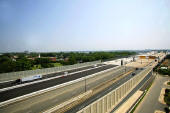 |
WWB Project
construction, photo taken from the roof of a Hunting Towers Apartment building
in Alexandria, Virginia, showing the completed new parallel 6-lane Potomac River
bridges, which are currently carrying 3 Beltway Outer Loop lanes
and 3 Beltway Inner Loop lanes on the local roadway of each respective bridge.
The next 4 photos are from the same vantage point, and the camera lens
zooms in successively.
|
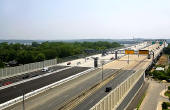 |
WWB
Project construction, photo taken from the roof of a Hunting Towers
Apartment building in Alexandria, Virginia, showing the completed new
parallel 6-lane Potomac River bridges, which are currently carrying 3
Beltway Outer Loop lanes and 3 Beltway Inner Loop lanes on the local
roadway of each respective bridge.
|
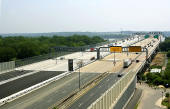 |
WWB
Project construction, photo taken from the roof of a Hunting Towers
Apartment building, showing the completed new parallel 6-lane Potomac
River bridges.
|
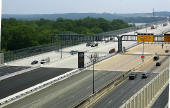 |
WWB
Project construction, photo taken from the roof of a Hunting Towers
Apartment building, showing the completed new parallel 6-lane Potomac
River bridges.
|
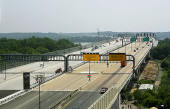 |
WWB Project
construction, photo taken from the roof of a Hunting Towers Apartment building,
showing the completed new parallel 6-lane Potomac River bridges.
The Outer Loop bridge (browner-colored concrete roadway) is to the right,
and the Inner Loop bridge (its newness results in the lighter-colored concrete
roadway) is to the left.
The second roadway from the right was temporarily used as the 3-lane Inner
Loop roadway from mid-2006 to mid-2008, and its traffic was moved to the permanent
3-lane local roadway on the Inner Loop bridge on June 1, 2008. The second
roadway from the right is without traffic until it is opened as the permanent
Outer Loop express roadway, and its line painting will be reconfigured for
that use.
The roadway line painting of the Outer Loop bridge 3-lane local roadway
is in its final configuration, with a solid yellow line 6 feet from the left
parapet, a solid white line 10 feet from the right parapet, and two white
dashed lines separating the 3 lanes of traffic.
The initial roadway line painting of the Outer Loop bridge 3-lane express
roadway was in a temporary configuration, since it handled Inner Loop traffic
for 24 months in the reverse direction of its final configuration. Heading
in the Virginia-bound direction, it had the above format, with a solid yellow
line 6 feet from the left parapet, a solid white line 10 feet from the right
parapet, and two white dashed lines separating the 3 lanes of traffic. After
the second new bridge opens to traffic in mid-2008, that 3-lane roadway (the
left lane will remain closed and is reserved for future transit use) will
be permanently reversed to handle Maryland-bound express traffic, so before
it opens in its permanent format, the roadway paint lines will have to be
removed so that it can be repainted in the correct format for Maryland-bound
traffic.
|
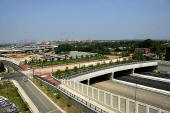 |
WWB Project
construction, photo taken from the roof of a Hunting Towers Apartment building,
showing the completed Washington Street Urban Deck in Alexandria VA. Washington
Street is the highway that crosses the Beltway, and its traffic was maintained
during construction over the Beltway. The completed Washington Street Deck
spans the entire reconstructed 12-lane Beltway, and the deck is over 200 feet
long and over 200 feet wide, and carries the 4-lane Washington Street with
landscaping over the rest of the deck.
On the nearside of the sound barrier there is a path, that is part of the
pedestrian/bicycle path that will connect the two states via a separated path
along the north edge of the Inner Loop WWB, and the trail will carry
pedestrian/bicycle traffic between US-1 south of Alexandria and pedestrian/bicycle
trails in Maryland. The pedestrian/bicycle trail will open to traffic in early
2009 when connecting facilities are completed.
|
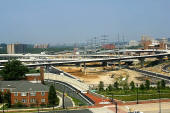 |
WWB Project
construction, photo taken from the roof of a Hunting Towers Apartment building,
showing part of the Washington Street Urban Deck, with construction of the
Beltway U.S. Route 1 Interchange in the distance.
The permanent Beltway Outer Loop 3-lane local roadway, and the permanent
Beltway Inner Loop 3-lane local roadway, built in the WWB Project, from just
east of the VA-241 Telegraph Road interchange to a couple hundred feet west
of the Washington Street Urban Deck at the US-1 interchange, were opened to
traffic within the last 8 months, and these openings have put all Beltway
mainline traffic on new roadways constructed as part of the WWB Project's
US-1 Interchange segment. Construction of the 3-lane express roadways is underway
between the local roadways.
On the nearside of the sound barrier there is a path, that is part of the
pedestrian/bicycle path that will connect the two states via a separated path
along the north edge of the Inner Loop WWB, and the trail will carry
pedestrian/bicycle traffic between US-1 south of Alexandria and pedestrian/bicycle
trails in Maryland.
|
Lead article -
Woodrow Wilson Bridge Project Photos
Copyright © 2008 by Scott Kozel. All rights reserved. Reproduction, reuse,
or distribution without permission is prohibited.
Back to top
By Scott M. Kozel, Capital Beltway
dot com, Roads to the
Future
(Created 10-3-2008)







